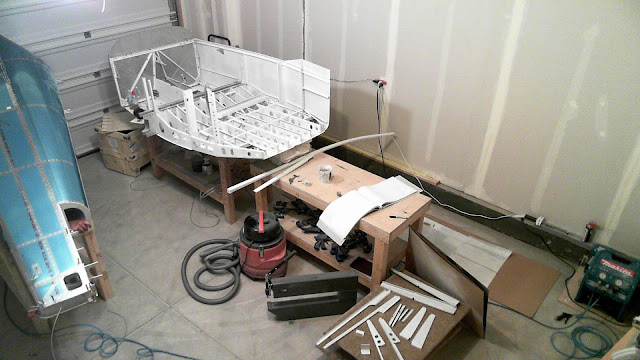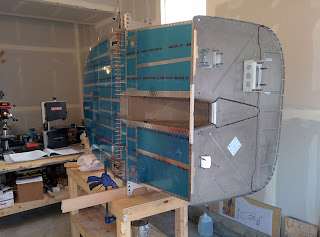It was on 4-Jul-14 that the bottom side skins were attached to the aft fuselage. At that point, the structure could no longer accommodate the top side and top skins as it would have made it too big to remove from the house. Thus, following the addition of various cables, rudder guides, static plumbing, bulkhead riveting and the aft deck, the structure imposed as an unwelcome couch-surfing roommate in my living room, along with the wings, until the future (now current) new house could offer the structure the space it beckoned for. I cleco'd the top skins on just for looks. They had to be removed so the structure could fit through the door when I moved to the new house.
And so, a little more than one year later, on 17-Jul-15, a gracious friend spent 4.5 hours with me to rivet the structure to near completion. Just a few rivets remain, including some match drilling for the vertical stabilizer (page 10-28) and this bad boy will be ready for attachment to the forward fuselage. Sections 11 (Empennage Attach) and 12 (Empennage Fairings) can be completed with the tail attached to the fuse.
The rivets along the longerons and bulkheads were bucked classically with a flat set and bar. The rivets attaching the top and top side skins were back
riveted with me sprawled out in the structure. The picture of me inside
the tail cone is less than modest, so it's left to the reader's
imagination. However here is one showing my wayward hand poking out from the inside of the tail onto the aft deck. You can also see the fuselage right side skin ready for riveting.
In hindsight, we should have done all of these top half rivets by back riveting with me inside the tail cone. I was hesitant to do it given how imposing it seemed. Other than the bearable discomfort of the protracted time in a confined space limiting my movement, it was easily accomplished.
Here is the nearly completed aft fuse.
In case you're wondering why the aft bulkhead no longer seems complete, see this post.




